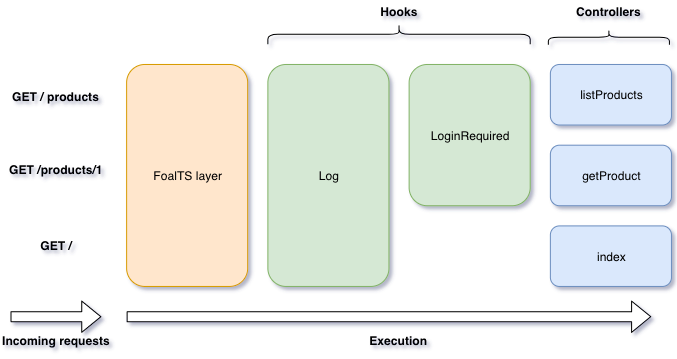Architecture Overview
FoalTS is a framework for creating server-side Node.js applications. It is written in TypeScript, a typed superset of JavaScript that provides advanced development tools and the latest language features.
FoalTS architecture is organized around three main components: controllers, services and hooks.
Controllers
Controllers are classes instantiated as singletons. Their methods process the incoming HTTP requests.
import { Get, HttpResponseOK } from '@foal/core';
class AppController {
@Get('/')
index() {
return new HttpResponseOK('Hello world!');
}
}
Services
Services are also classes instantiated as singletons. They are used by the controllers (or hooks) to perform specific tasks.
import { dependency, Get, HttpResponseOK } from '@foal/core';
class FormatService {
withDate(message: string): string {
return `${new Date()} - ${message}`;
}
}
class AppController {
@dependency
format: FormatService;
@Get('/')
index() {
const message = this.format.withDate('Hello world!');
return new HttpResponseOK(message);
}
}
Hooks
Hooks are small functions that add extra logic before or after the execution of a controller method.
import { Get, HttpResponseOK } from '@foal/core';
import { JWTRequired } from '@foal/jwt';
class AppController {
@Get('/')
@JWTRequired()
index() {
return new HttpResponseOK('Hello world!');
}
}
A Simple Application
Controllers may have sub-controllers. Hooks can be attached to the controllers or their methods.
Here's an example of what a FoalTS application may look like.
import { Context, controller, Get, HttpResponseNotFound, HttpResponseOK, Log } from '@foal/core';
import { JWTRequired } from '@foal/jwt';
@JWTRequired()
class ApiController {
private products = [
{ id: 1, name: 'phone' },
{ id: 2, name: 'computer' },
]
@Get('/products')
listProducts() {
return new HttpResponseOK(this.products);
}
@Get('/products/:id')
getProduct(ctx: Context) {
const product = this.products.find(
p => p.id === parseInt(ctx.request.params.id, 10)
);
if (!product) {
return new HttpResponseNotFound();
}
return new HttpResponseOK(product);
}
}
@Log('Receiving a request...')
class AppController {
subControllers = [
controller('/api', ApiController)
];
@Get('/')
index() {
return new HttpResponseOK('Welcome!');
}
}
